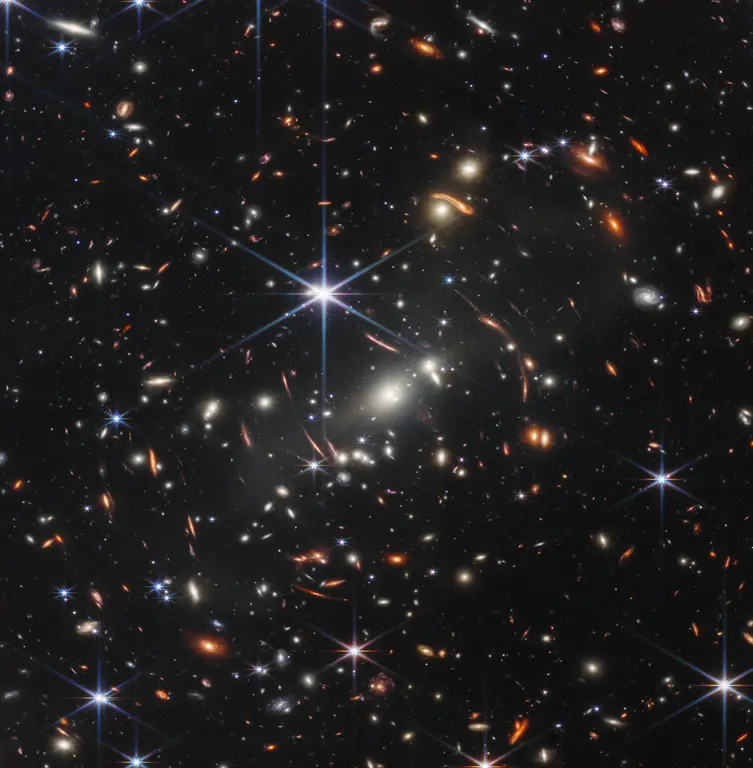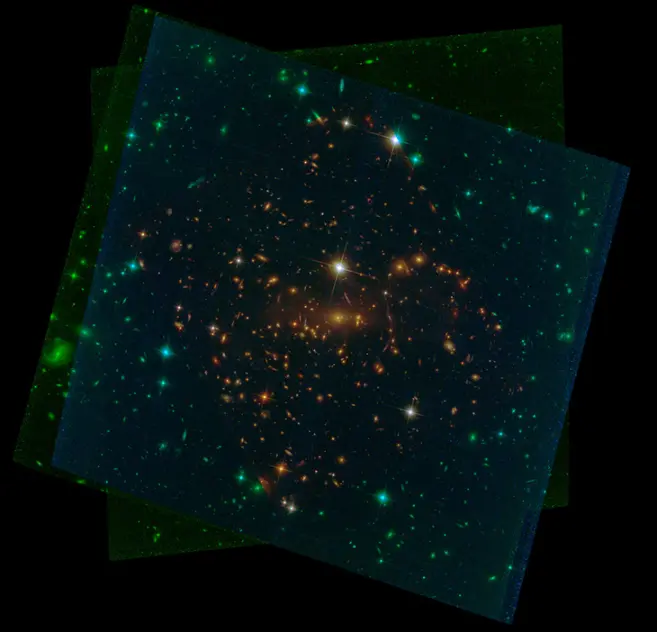The galaxy cluster SMACS 0723 (SMACS J0723.3-7327) is one of the first targets to be imaged by NASA’s James Webb Space Telescope (JWST). The massive cluster lies in the southern constellation Volans (the Flying Fish), at a distance of 4.24 billion light-years.
The galaxy cluster acts as a gravitational lens, bending the light of some of the most distant galaxies seen to date. These galaxies lie behind the cluster and appear in the JWST image as arcs of light around it.
One of the goals in launching the James Webb Space Telescope was to peer into galaxies as they appeared when the universe was still in its infancy. Massive clusters of galaxies like SMACS 0723 allow astronomers to see some of these galaxies, whose light is magnified and bent by the sheer mass of the clusters in the foreground.

James Webb Telescope’s first deep field, credit: NASA, ESA, CSA, and STScI
The deep field image of SMACS 0723 covers an area only 2.4 arcminutes across. It shows the foreground cluster as it appeared 4.6 billion years ago. The full-resolution image is available at WebbTelescope.org.
SMACS 0723 was previously imaged by Hubble. While the images appear somewhat similar, the JWST image is richer, offering a view of thousands of distant galaxies in unprecedented detail. The new space telescope has superior light gathering power and was able to capture many more distant galaxies in the same field, including the faintest objects ever seen in the infrared. Some of the galaxies in the image are shown as they appeared more than 13 billion years ago, when the universe was still very young.

SMACS J0723.3-7327 galaxy cluster. Credit: This work is based on observations taken by the RELICS Treasury Program (GO 14096) with the NASA/ESA HST, which is operated by the Association of Universities for Research in Astronomy, Inc., under NASA contract NAS5-26555
The deep field image was produced using Webb’s Near-Infrared Camera (NIRCam). It is a composite created from images taken at different wavelengths with a total exposure time of 12.5 hours. The images were taken on June 7, 2022. In comparison, the deep field images produced by NASA’s Hubble Space Telescope took weeks and did not achieve such depths.
The image of SMACS 0723 was unveiled by US President Joe Biden at a White House event on July 11, 2022. It was one of the first five full-colour images produced by the JWST to be released. The other four targets imaged by the telescope were the Carina Nebula in Carina, the Southern Ring Nebula (Eight-Burst Nebula, NGC 3132) in Vela, Stephan’s Quintet in Pegasus, and the gas giant exoplanet WASP-96b located about 1,120 light-years away in Phoenix.
SMACS J0723.3-7327
| Constellation | Volans |
| Right ascension | 07h 23m 19.5s |
| Declination | -73° 27′ 15.6” |
| Distance | 4.24 billion light years |
| Redshift | z = 0.39 |
| Names and designations | SMACS 0723-73, SMACS J0723.3-7327, 1RXS J072319.7-732735 |